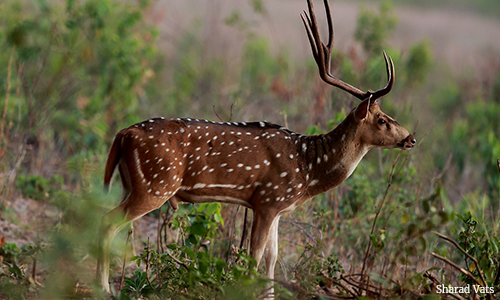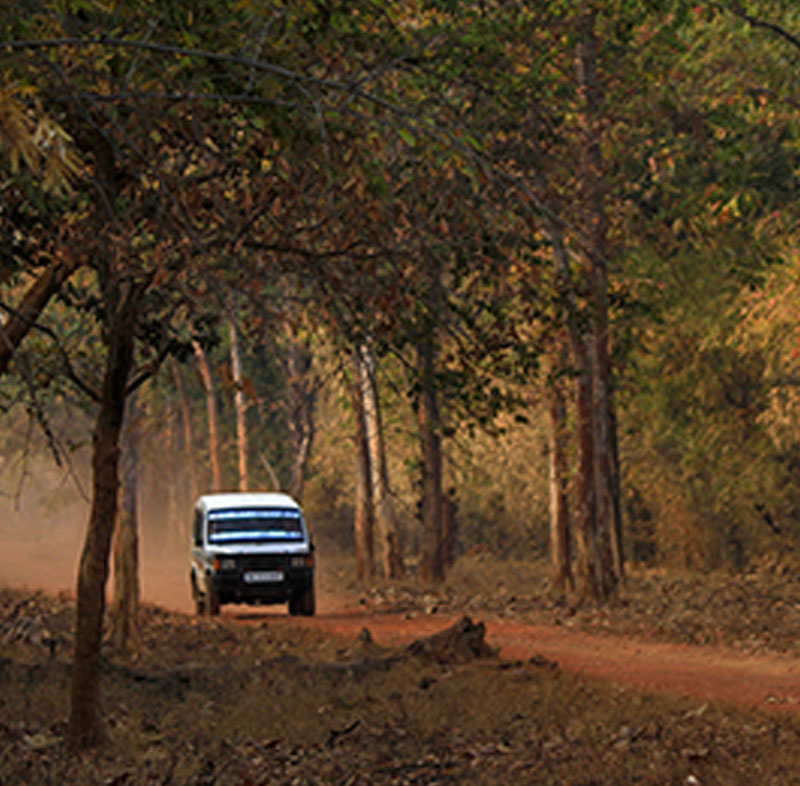Tadoba is a haven for flora and fauna. It is a beautiful southern tropical dry deciduous forest that is full of Teak, Ain (crocodile bark), Mahua, Tendu, and several other indigenous plant species. Thickets of bamboo and several medicinal trees grow wild in these forests and create a stunning habitat for wildlife. Tadoba spans the Chimur hills, and the landscape is undulating forest, which opens out onto tranquil meadow and grasslands. A beautiful water hole is flanked by gigantic Arjun trees, which lend a deep sense of serenity. It’s worth visiting Tadoba at different times of year – including the monsoon – to see the transformation that takes place in the wilderness. While the keystone species here is the tiger, the park is home to a wide range of animals and birds, both large and small, which makes it well worth a visit!

Tadoba is situated in the east of Maharashtra. It is the southernmost tiger reserve on the Central India circuit.

Topography: Tadoba is dominated by the gently rolling hills of the Chimur range. This beautiful habitat is a southern tropical dry deciduous forest and has several indigenous trees, particularly those with medicinal properties.
In Season: The park is open…
Year round. Tadoba is one of the very few national parks in India that one can even visit during the monsoon.
Tadoba has a large population of tigers, both within the core zone and in the immediate buffer areas. It is the oldest tiger park in Maharashtra and is one of the original sanctuaries that were earmarked for tiger conservation under Project Tiger.
The primary carnivore in Tadoba is the tiger. At last count, there were 88 tigers in the national park, and another 58 in the neighboring forests. Not only does Tadoba have a robust population of tigers, it has also seen the birth of several cubs in recent years. It forms a corridor with Pench National Park, and through Pench, with Kanha, which is vital for the animals to migrate from one zone to another. Tadoba has a healthy population of leopards as well as smaller cats such as the jungle cat and civet cat. Sloth bears, hyenas and the marsh crocodile are among the other larger predators in these jungles. Tadoba is also home to several birds of prey, especially eagles.
Several herbivores inhabit these forests. There is a healthy prey-base of Cheetal (Spotted Deer), Sambhar, Chausingha (a variety of antelope) and Barking Deer. Honey badgers, terrapins and the Indian Star Tortoise are some of the other creatures that one can find here. Tadoba’s forests also have several snakes ncluding the Russel’s Viper, the Indian King Cobra, and the Indian Python. Don’t be startled if you suddenly see a giant monitor lizard dart out of the bushes. These large lizards proliferate in this dense forest.
Tadoba is home to approximately 195 different species of birds. Water birds in particular flock to the lake that is located within the jungle. Several unusual birds such as the orange-headed Thrush, the black-naped blue Flycatcher, and the Indian Pitta are found here. Peacocks abound, and their calls can be heard throughout the jungle, especially before the monsoon.
The nearest airport is at:
The nearest railway stations are at:

Game drives by jeep – you can opt to book your own jeep or share with other passengers.

November to March is the best time to visit Tadoba National Park.
Winters can be extremely chilly and the wind-chill factor is high, especially on the early morning game drives. It’s advisable to bundle up warmly. As the sun rises though, it warms up to a pleasant temperature during the day time, but the chill sets in again as soon as the sun sets. Summers are extremely hot. Temperatures can reach as high as 45-48 degrees Celsius (well over 100 degrees Fahrenheit) and it can get extremely dry. The monsoon usually lasts from July through the end of September.
Bamboo Forest Lodge :
What we love…gorgeous views overlooking Lake Maasal from each room, which has an eco-friendly touch.
Svasara :
What we love…the forest nursery of native plants and shrubs that Svasara has incubated on its own property, as part of its eco-friendly vision.
Tiger Trail Lodge:
What we love…the “re-wild” ethos. The team at Tiger Trails took over a piece of land that had been completely depleted and over the last nineteen years, they have literally resurrected it through water conservation and replanting the habitat.
Irai Retreat:
What we love…the jungle bush camp feel to the place. It is situated close to the Irai water body.
Jharana Jungle Lodge:
What we love…organic and nutritious cuisine prepared by their in-house chefs from locally sourced produce and vegetables.
There is only one main trail for jeeps that runs around the park, and there are six gates: Navegaon Gate, Kolara Gate, Moharli Gate, Kuswanda , Pangadi Gate, Zari Gate. Only a handful of jeeps, ranging from 4 – 9, are permitted to enter the park at each gate.
Tadoba is located in Chandrapur district in Maharashtra, which has been designated a “dry district” by the state government. Therefore none of the lodges in Tadoba are permitted to serve liquor to guests.